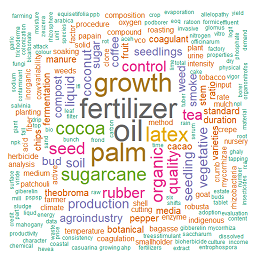Upaya Menekan Kehilangan Hasil Produksi Kelapa Sawit pada Daerah Bukit Bergunung dan Daerah Datar Bergelombang
DOI:
https://doi.org/10.25181/jaip.v11i2.2919Keywords:
harvest management, labour experience, losses, topography, weed controlAbstract
Oil palm is a plant that produces vegetable oil and is cultivated in various terrain, including undulating flats and mountainous hills. The aim of this study was to identify the factors causing losses in these areas and to investigate ways to reduce the production and income effects of these losses. The research was conducted at the Palm Oil Plantation of PT. Supra Matra Abadi in North Sumatra Province, using a quantitative research method. Samples were taken from blocks A, B (planted in 1988) and C, D (planted in 2016). The parameters observed included the number of losses in the circle, path, and collection point of FFB, areas, plant age, and the suitability and completeness of equipment. Treatments included spraying on circles, paths, and collection points of FFB, as well as the placement of employees based on their experience level and the provision of tools. Data analysis was conducted using the t-test to compare results before and after treatment. The study found that the highest losses occurred in mountainous hill areas, with an average of 2.394 kg.ha-1, while the lowest losses occurred in undulating flat areas, with an average of 1.420 kg.ha-1. The results also showed that losses decreased by 28.17% or 0.678 kg.ha-1 in mountainous hill areas and by 36.93% or 0.522 kg.ha-1 in undulating flat areas after treatment. The economic value of losses was IDR 2,271.30 per ha in mountainous hill areas and IDR 1,748.70 per ha in undulating flat areas. Therefore, this study concludes that the spray treatment of circles, paths, collection point of FFB, placement of employees based on their experience level, and provision of equipment significantly reduced losses in undulating flat areas and mountainous hills.Downloads
References
Abubakar, A., & Ishak, M. Y. (2022). An Overview of the Role of Smallholders in Oil Palm Production Systems in Changing Climate. Nature Environment and Pollution Technology, 21(5), 2055–2071. https://doi.org/10.46488/NEPT.2022.v21i05.004
Abubakar, A., Ishak, M. Y., Bakar, A. A., Uddin, M. K., Ahmad, M. H., Seman, I. A., Ching, L. M., Ahmad, A., & Hashim, Z. (2023). Geospatial simulation and mapping of climate suitability for oil palm (Elaeis guineensis) production in Peninsular Malaysia using GIS/remote sensing techniques and analytic hierarchy process. Modeling Earth Systems and Environment, 9, 73–96. https://doi.org/10.1007/s40808-022-01465-9
Ali, N. B. M., Karim, M. F. A., Saharizan, N., Adnan, N. S., Mazri, N. H., Fikri, N. A., Amaludin, N. A., & Zakaria, R. (2021). Weeds diversity in oil palm plantation at Segamat, Johor. IOP Conference Series: Earth and Environmental Science, 756(1), 1–12. https://doi.org/10.1088/1755-1315/756/1/012034
Ambar Suharyanti, N., Mizuno, K., & Sodri, A. (2020). The effect of water deficit on inflorescence period at palm oil productivity on peatland. E3S Web of Conferences, 211, 2–11. https://doi.org/10.1051/e3sconf/202021105005
Burga, E., Gunawan, S., & Yuniasih, B. (2021). Perhitungan Jumlah Losses Kelapa Sawit pada Topografi yang Berbeda. Jurnal Agromast, 2(1).
Fackrurrozi, Junaedi, A., & Matra, D. D. (2019). Manajemen Pemanenan Kelapa Sawit (Elaeis guineensis Jacq.) di Kebun Rambutan, Serdang Bedagai, Sumatera Utara. Buletin Agrohorti, 7(3), 319–328. https://doi.org/10.29244/agrob.v7i3.30259
Haloho, B. V., Puspita, & Yuanita. (2021). Evaluasi Mutu Panen Kelapa Sawit di PT. Sentosa Kalimantan Jaya. Jurnal Agriment, 6(2), 81–89. https://doi.org//10.51967/jurnalagriment.v6i2.513
Hasibuan, B. R., Rahayu, E., & Astuti, Y. T. M. (2018). Kajian Pengaruh Topografi Terhadap Produksi Kelapa Sawit di PT. Gunung Sejahtera Yoli Makmur (GSYM) Kecamatan Arut Utara, Kabupaten Kotawaringin Barat, Kalimantan Tengah. Jurnal Agromast, 3(1).
Khasanah, N., van Noordwijk, M., Ningsih, H., & Rahayu, S. (2015). Carbon neutral? No change in mineral soil carbon stock under oil palm plantations derived from forest or non-forest in Indonesia. Agriculture, Ecosystems and Environment, 211, 195–206. https://doi.org/10.1016/j.agee.2015.06.009
Manurung, R. P., Santosa, T. N. B., & Ginting, C. (2017). Kajian Losses Brondolan di Perkebunan Kelapa Sawit di Kebun Aek Tarum, PT. Gunung Melayu, Asian Agri Group Desa Batu Anam, Kecamatan Rahuning, Kabupaten Asahan, Provinsi Sumatera Utara. Jurnal Agromast, 2(2).
Noviana, G., & Ardiani, F. (2020). Analisis Pendapatan Petani Kelapa Sawit Sebelum dan Selama Covid-19 (Studi Kasus: Kabupaten Padang Lawas Utara). MEDIAGRO, 16(2), 1–8. https://doi.org/10.31942/md.v16i2.3751
Nugraha, M. A. S., Gunawan, S., & Santi, I. S. (2018). Pengaruh Kualitas Panen Terhadap Losses Diperkebunan Kelapa Sawit Di Pt Wanasawit Subur Sumber Lestari 2 M. Jurnal Agromast, 3(1).
Omar, Z., & Fatah, F. A. (2020). Unravelling the factors affecting agriculture profitability enterprise: Evidence from coconut smallholder production. Accounting, 6(4), 493–500. https://doi.org/10.5267/j.ac.2020.4.009
Rahman, N., Giller, K. E., de Neergaard, A., Magid, J., van de Ven, G., & Bruun, T. B. (2021). The effects of management practices on soil organic carbon stocks of oil palm plantations in Sumatra, Indonesia. Journal of Environmental Management, 278, 111446. https://doi.org/10.1016/j.jenvman.2020.111446
Sitinjak, R. R. (2021). Potential of the Mixture of Cocoa (Theobroma cacao L.) Pulp Water with Glyphosate in Controlling Weeds in Oil Palm Plantations. Tropical Journal of Natural Product Research, 5(11), 1940–1944. https://doi.org/10.26538/tjnpr/v5i11.8
Sofiana, Y., & Yahya, S. (2015). Manajemen Panen Kelapa Sawit (Elaeis guineensis Jacq.) Di Kebun Tambusai Kec. Tambusai, Kabupaten Rokan Hulu, Riau. Buletin Agrohorti, 2(3), 213–220.
Tao, H. H., Slade, E. M., Willis, K. J., Caliman, J. P., & Snaddon, J. L. (2016). Effects of soil management practices on soil fauna feeding activity in an Indonesian oil palm plantation. Agriculture, Ecosystems and Environment, 218, 133–140. https://doi.org/10.1016/j.agee.2015.11.012
Utomo, B. (2014, September). Konsistensi Membangun Budaya Kontrol: Upaya Menghilangkan Losses Produksi. Majalah Sawit Indonesia. https://sawitindonesia.com/konsistensi-membangun-budaya-kontrol-upaya-menghilangkan-losses-produksi/
Woittiez, L. S., van Wijk, M. T., Slingerland, M., van Noordwijk, M., & Giller, K. E. (2017). Yield Gaps in Oil Palm: A Quantitative Review of Contributing Factors. European Journal of Agronomy, 83, 57–77. https://doi.org/10.1016/j.eja.2016.11.002
Downloads
Published
How to Cite
Issue
Section
License
Copyright (c) 2023 Dewa Riski, Sri Gunawan, Fani Ardiani

This work is licensed under a Creative Commons Attribution-ShareAlike 4.0 International License.
Authors who publish with Jurnal Agro Industri Perkebunan agree to the following terms:
Authors retain copyright and grant the Jurnal Agro Industri Perkebunan right of first publication with the work simultaneously licensed under a Creative Commons Attribution License (CC BY-SA 4.0) that allows others to share (copy and redistribute the material in any medium or format) and adapt (remix, transform, and build upon the material for any purpose, even commercially) with an acknowledgment of the work's authorship and initial publication in Jurnal Agro Industri Perkebunan.
Authors are able to enter into separate, additional contractual arrangements for the non-exclusive distribution of the journal's published version of the work (e.g., post it to an institutional repository or publish it in a book), with an acknowledgment of its initial publication in Jurnal Agro Industri Perkebunan. Authors are permitted and encouraged to post their work online (e.g., in institutional repositories or on their website) prior to and during the submission process, as it can lead to productive exchanges, as well as earlier and greater citation of published work.


























